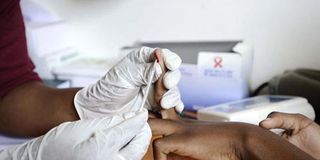63 districts covered in the ongoing HIV/Aids survey

63 districts covered in the ongoing HIV/Aids survey
What you need to know:
- The $4m survey, which was rolled out in August last year, by the Ministry of Health through the International Centre for Aids programmes (ICAP) is largely funded by the US Centre for Disease Control.
- The previous round of Aids Indicator Surveys show that HIV prevalence in the general population in Uganda increased from 6.4 per cent in 2004/5 to 7.3 per cent by 2011, tallying with the 2013 HIV estimates, which show that HIV prevalence stabilised around 7.4 per cent in 2012/2013.
KAMPALA. Government has completed a survey in 63 of the original 112 districts, set to determine the new HIV infection and national disease prevalence rates, currently estimated at 7.3 per cent as per the last survey in 2011.
The Uganda Population-Based HIV Impact Assessment (UPHIA), the fourth HIV/Aids study of its kind in Uganda since the 1980s, will cover 40,000 randomly selected participants from 520 villages countrywide.
Dr Alex Opio, the UPHIA survey director, said preliminary results will be released in March while the final results of the survey would be released at the end of the year.
“It will help us in the implementation of the 90-90-90 Joint United Nations Programme on HIV/Aids (UNAIDS) targets campaign to achieve 90 per cent of HIV/Aids patients diagnoses, 90 per cent on treatment and 90 per cent virally suppressed by 2030 and give a better understanding of where we have reached in the fight against HIV/Aids,” Dr Opio said.
Dr Opio was speaking during the handover of three vehicles donated by the Centres for Disease Control and Prevention (CDC), a global non-government organisation, to the Ministry of Health to be used in field supervision of the survey.
The $4m survey, which was rolled out in August last year, by the Ministry of Health through the International Centre for Aids programmes (ICAP) is largely funded by the US Centre for Disease Control.
For effective planning and monitoring of the HIV/Aids prevalence, Dr Joshua Musinguzi the Programme Manager of the Aids Control Programme, said the survey will be conducted every two to three years instead of five as it has been in the past.
“Although we have been carrying out an annual centenary surveillance to update the data on HIV/Aids, what we call modelling, it is not as representative,” Dr Musinguzi explained that such data just estimates what happens on ground.
He added that other than determining the prevalence rate of the HIV/Aids in the country, the survey, among others would help to determine the Syphilis and hepatitis B prevalence
The previous round of Aids Indicator Surveys show that HIV prevalence in the general population in Uganda increased from 6.4 per cent in 2004/5 to 7.3 per cent by 2011, tallying with the 2013 HIV estimates, which show that HIV prevalence stabilised around 7.4 per cent in 2012/2013.




